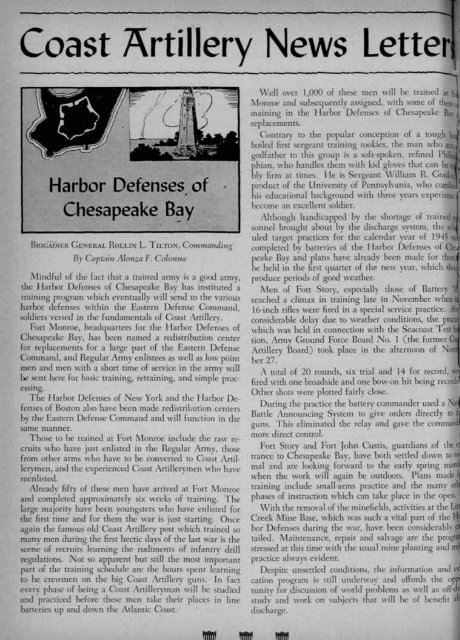January-February - Air Defense Artillery
January-February - Air Defense Artillery
January-February - Air Defense Artillery
Create successful ePaper yourself
Turn your PDF publications into a flip-book with our unique Google optimized e-Paper software.
Coast ~rtillery News Lette<br />
Harbor Defens'es of<br />
.<br />
Chesapeake B~y<br />
BRlG~\DIER Gm~ERAL ROLLIN L. TILTON, C01l1111mldillo ~<br />
By Captain Alonza F. Colo1ll1l1<br />
i\lindful of the fact that a trained army is a good am1Y,<br />
the Harbor <strong>Defense</strong>s of Chesapeake Bay has instituted a<br />
training program which eventually will send to the various<br />
harbor defenses within the Eastern <strong>Defense</strong> Command,<br />
soldiers versed in the fundamentals of Coast Artillen'.<br />
Fort Monroe, headquarters for the Harbor Defe,;ses of<br />
Chesapeake Bay, has been named a redistribution center<br />
for replacements for a large part of the Eastern <strong>Defense</strong><br />
Command, and Regular Army enlistees as well as low point<br />
men and men with a short time of service in the army will<br />
be sent here for basic training, retraining, and simple processing.<br />
The Harbor <strong>Defense</strong>s of New York and the Harbor <strong>Defense</strong>s<br />
of Boston also have been made redistribution centers<br />
by the Eastern <strong>Defense</strong> Command and will function in the<br />
same manner.<br />
Those to be trained at Fort l'vlonroe include the raw recruits<br />
who have just enlisted in the Regular Army, those<br />
from other arms who have to be converted to Coast <strong>Artillery</strong>men,<br />
and the experienced Coast <strong>Artillery</strong>men who have<br />
reenlisted.<br />
Already fifty of these men have arrived at Fort Monroe<br />
and completed approximately six weeks of training. The<br />
large majority have been youngsters who have enlisted for<br />
the first time and for them the war is just starting. Once<br />
again the famous old Coast <strong>Artillery</strong> post which trained so<br />
many men during the first hectic days of the last war is the<br />
scene of recruits learning the rudiments of infantry drill<br />
regulations. Not so apparent but still the most important<br />
part of the training schedule are the hours spent learning<br />
to be crewmen on the big Coast <strong>Artillery</strong> guns. In fact<br />
every phase of being a Coast <strong>Artillery</strong>man will be studied<br />
and practiced before these men take their places in line<br />
batteries up and down the Atlantic Coast.<br />
\Vell over 1.000 of these men will be trained at<br />
i\lonroe and subsequently assigned, with some of them<br />
maining in the Harbor <strong>Defense</strong>s of Chesapeake Ba<br />
replacements.<br />
Contrary to the popular conception of a tough<br />
boiled first sergeant training rookies, the man who<br />
godfather to this group is a soft-spoken, refined Phi<br />
phian, who handles them with kid gloves that can be<br />
bl" firm at times. He is Sergeant William R. Gor<br />
p(oduct of the University of Pennsyh'ania, who COm<br />
his educational backoround with three vears eXIJerielX'<br />
o ,<br />
become an excellent soldier.<br />
Although handicapped by the shortage of trained<br />
sonnel brought about by the discharge system, the s<br />
uled target practice~ for. the calendar year of 1945<br />
completed by battenes ol the Harbor <strong>Defense</strong>s of C<br />
peake Bay and plans have already been made for those<br />
be held in the first quarter of the new year, which s<br />
produce periods of good weather.<br />
Men of Fort Story, especially those of Battery<br />
reached a climax in training late in November when<br />
16-inch rifles were fired in a special service practice. l<br />
considerable delay due to weather conditions, the pra<br />
which was held in connection with the Seacoast Test<br />
tion, Annv Ground Force Board No.1 (the former<br />
<strong>Artillery</strong> Board) took place in the afternoon of N<br />
her 27.<br />
A total of 20 rounds, six trial and 14 for record.<br />
fired with one broadside and one bow-on hit being record<br />
Other shots were plotted fairly close. ~<br />
During the practice the battery commander used a 1\<br />
Battle Announcing System to give orders directly to<br />
ouns. This eliminated the relav and ooavethe comma<br />
o •<br />
more direct control.<br />
Fort Story and Fort John Custis, guardians of the er<br />
trance to Chesapeake Bay, have both settled down to<br />
mal and are looking forward to the early spring man<br />
when the work will again be outdoors. Plans made<br />
training include small-arms practice and the many ot<br />
phases of instruction which can take place in the open.<br />
\Vith the removal of the minefields, activities at the Li<br />
Creek iVline Base, which was such a vital part of the<br />
bor <strong>Defense</strong>s during the war, have been considerably<br />
tailed. Maintenance, repair and salvage are the prog<br />
stressed at this time with the usual mine planting and m<br />
practice always evident.<br />
Despite unsettled conditions, the information and ed<br />
cation program is still underway and affords the op<br />
tunity for discussion of world problems as well as off-d<br />
studv and work on subjects that will be of benefit<br />
discharge ..
















